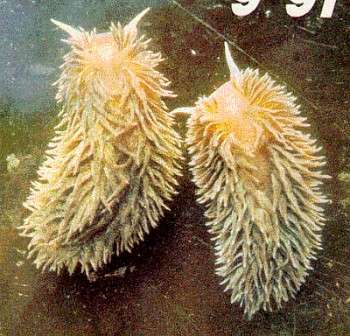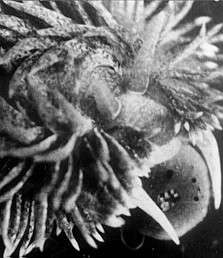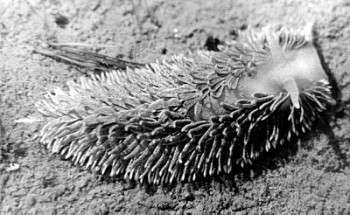Aeolidia papillosa from the White Sea
September 8, 1999
From: Irina Roginskaya

Dear Bill!
Are you interested in Aeolidia papillosa from the White Sea? Here are photos of A. papillosa collected near the White Sea Biological Station of Moscow State University at Kandalaksha Bay. The one in colour and a specimen, eating the actiniarian, I took in September 1987; the specimen sliding over sandy bottom - a year earlier. A. papillosa is one of the commonest nudibranchs in the vicinity of the Biological Station and one of the largest : some specimens could attain as long as 70 mm. They are preying on two species of actiniarians: Bunodactis stella (Verrill) (= Aulactinia stella (Verrill) according to Dunn,Chia and Levine, 1980) in the littoral environment, and on Metridium senile (Verrill) in the sublittoral zone. During the long spawning period of A. papillosa, from June up to the end of September, the spirally coiled festoon shaped egg-strings of the species can be regularly seen attached to the stems of Zostera, stones and empty shells of Bivalvia. The largest egg-masses may contain up to millions of eggs. Producing the large egg masses may take A. papillosa as much as 16-18 hours. There are usually more than one egg in the egg-capsule, sometimes - up to 19 eggs. The diameter of the fertilized eggs is 78-80 microns.
P.S. The colour photo had been published in Roginskaya I.S. & Reller N.B. (1991) Nudibranchia versus Cnidaria, Priroda, 9: 64-70.
Best wishes,
Irina.
irina7@hotmail.com


Dear Irina,
Of course we're interested in Aeolidia from the White Sea. The photo of it eating the small anemone is interesting because it seems to be exhibiting the behaviour I described for Spurilla australis in Australia. I have only seen S. australis feeding on a relatively small anemone, Cricophorus nutrix which lives on laminarian brown algae. The anemone quickly releases its hold on the algae when disturbed, so that it falls off and escapes. In an apparent behavioural 'trick' to avoid losing the anemone, Spurilla australis wraps its oral tentacles around the anemone as it takes a bite. This seems to be what your Aeolidia is doing in the photo.
Bill Rudman.
Related messages
-
Aeolidia papillosa from French Atlantic
From: Marina Poddubetskaia Ossokine, August 17, 2009 -
Re: Aeolidia papillosa spawn
From: Jackie Hildering, August 1, 2008 -
Re: Aeolidia papillosa spawn
From: Jackie Hildering, August 1, 2008 -
Stars don't eat slugs
From: Jan Kocian, July 11, 2007 -
Aeolidia papillosa from British Columbia
From: Marli Wakeling, March 26, 2007 -
Aeolidia papillosa? from southern Oregon
From: Sandy Grummon, March 1, 2007 -
Large Aeolidia papillosa from Puget Sound
From: Richard Zade, February 8, 2007 -
Juvenile Aeolidia papillosa?
From: Carmelita Hansen, May 11, 2006 -
Aeolidia papillosa - Mating and Feeding
From: Philipp Kauffmann, May 24, 2005 -
Aeolidia papillosa from Puget Sound, Washington
From: Tom Hankins, February 22, 2005 -
Aeolidia papillosa vs Flabellina salmonacea
From: Mary Jo Adams, January 29, 2004 -
Aeolidia papillosa - mating
From: Richard Lord, August 29, 2003 -
Aeolidia papillosa feeding
From: Alan Shepard, August 23, 2003 -
Re: Information about Aeolidia papillosa
From: Peter H. van Bragt, November 4, 2002 -
Information about Aeolidia papillosa
From: Moria Eggers, October 30, 2002 -
Aeolidia papillosa feeding
From: Andy Horton, September 30, 1999 -
Aeolidia papillosa spawn
From: Andy Horton, September 29, 1999 -
Albino Aeolidia papillosa
From: Irina Roginskaya, September 18, 1999 -
Colour variation in Aeolidia papillosa
From: Betsey Hansen, September 5, 1999 -
Aeolidia papillosa - Feeding & breeding
From: Betsey Hansen, September 3, 1999 -
Aeolidia papillosa from the Netherlands
From: Peter H. van Bragt, September 2, 1999 -
Aeolidia papillosa from New York
From: Betsey Hansen, September 2, 1999
